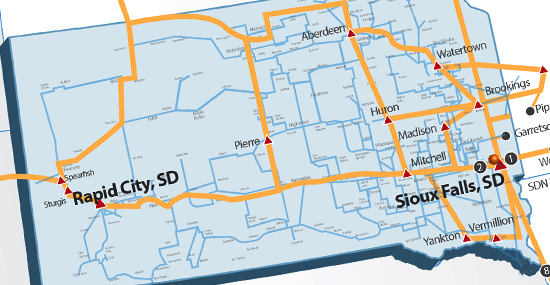
Driving across South Dakota from Brookings to Belle Fourche will put about 450 miles on your vehicle’s odometer. Make the drive between the two cities 100 times and you’ll get a strong appreciation for how far 45,000 miles is.
That’s the newest estimate of the ever-increasing amount of fiber optic lines that SDN Communications and 18 members of the South Dakota Telecommunications Association have buried across the state to serve their customers.
The 45,000 mileage total is a numerical byproduct of data compiled by the state’s telecommunications industry for “Connecting South Dakota’s Future: A Report on the Deployment & Impact of Rural Broadband.” SDTA and SDN recently released the report.
It’s a significant number because it reflects the impressive headway South Dakota continues to make in establishing itself as a well-connected state, from border to border.
Old copper networks sufficed 20 years ago and still have a place in telecommunications. But the world increasingly depends on information that can be delivered at the speed of light over hair-like, fiber optic lines.
Industry officials had been citing an older estimate of 30,000 miles when talking about the membership’s fiber in the state. Fresh information from companies was expected to increase the estimated total, but a 50 percent jump to 45,000 miles was pleasantly surprising to industry officials.
“I think it reflects a couple of things. First of all, the commitment and foresight these companies have in investing a significant amount of money into their networks in order to provide state-of-the-art services to their customers,” said Greg Dean, director industry relations for the SDTA.
Fiber networks enable the best options for providing advanced telecommunications services now and in the future, he said.
“So these companies are looking well into the future to provide services for 20, 30, 40 years and beyond,” Dean said, and they’re investing heavily in rural areas. “They’re really planning for networks to have services and applications that haven’t even been dreamed up yet.”
The updated fiber estimate isn’t included in the 2018 “Connecting South Dakota’s Future” report. But the number is based on data that was compiled for the report, according to Dean and Richard Coit, executive director of the SDTA.
SDTA’s 18 member companies serve largely rural areas. Most are also investor-owners in Sioux Falls-based SDN, which specializes in providing broadband connectivity and cybersecurity services to businesses.
SDTA members believe broadband infrastructure and services are revolutionizing life in small cities and rural communities across the state, Coit says in the report. The SDTA supports public policies that allow its member companies to deploy the newest and best communications technologies at affordable costs, he says, and good public policy is based on solid facts. The report can help provide some of those facts and possibly help guide future policy.
The report was compiled with help from South Dakota Dashboard, an online, community information service.
“The pace of broadband deployment bodes well for rural communities because the internet is rapidly becoming a central marketplace for the exchange of goods and services,” said regional economist Jared McEntaffer, project director with Dashboard.
The study documents that residents of rural South Dakota generally are ahead of the curve in the quality of broadband services that they receive. Rural telecoms in South Dakota are building out fiber-to-the-premise networks faster than their rural counterparts.
Nationally, surveys indicate that as of 2016, more than 40 percent of U.S. customers served by rural telecoms had fiber-to-the-premise connectivity. In comparison, about 65 percent of customers served by SDTA members had fiber service.
And the number of fiber miles is steadily increasing. Just take a look at the related blog below.

Download a copy of the broadband report using the button below.




